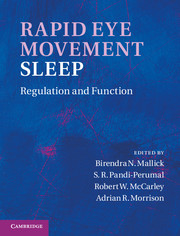Book contents
- Frontmatter
- Contents
- Contributors
- Preface
- Acknowledgments
- Organization
- Section I Historical context
- Section II General biology
- Section III Neuronal regulation
- 10 Understanding REM sleep: clues from brain lesion studies
- 11 Preoptic and basal forebrain modulation of REM sleep
- 12 Amygdalar regulation of REM sleep
- 13 Pontomedullary mediated REM-sleep atonia
- 14 Phenomenology and function of myoclonic twitching in developing rats
- 15 Pontine-wave generator: a key player in REM sleep-dependent memory consolidation
- 16 Hippocampal theta rhythm of REM sleep
- 17 Respiration during REM sleep and its regulation
- 18 Modulation of REM sleep by non-REM sleep and waking areas in the brain
- Section IV Neuroanatomy and neurochemistry
- Section V Functional significance
- Section VI Disturbance in the REM sleep-generating mechanism
- Index
- Plate section
- References
12 - Amygdalar regulation of REM sleep
from Section III - Neuronal regulation
Published online by Cambridge University Press: 07 September 2011
- Frontmatter
- Contents
- Contributors
- Preface
- Acknowledgments
- Organization
- Section I Historical context
- Section II General biology
- Section III Neuronal regulation
- 10 Understanding REM sleep: clues from brain lesion studies
- 11 Preoptic and basal forebrain modulation of REM sleep
- 12 Amygdalar regulation of REM sleep
- 13 Pontomedullary mediated REM-sleep atonia
- 14 Phenomenology and function of myoclonic twitching in developing rats
- 15 Pontine-wave generator: a key player in REM sleep-dependent memory consolidation
- 16 Hippocampal theta rhythm of REM sleep
- 17 Respiration during REM sleep and its regulation
- 18 Modulation of REM sleep by non-REM sleep and waking areas in the brain
- Section IV Neuroanatomy and neurochemistry
- Section V Functional significance
- Section VI Disturbance in the REM sleep-generating mechanism
- Index
- Plate section
- References
Summary
Summary
The amygdala has a long-recognized role in emotion, and a growing body of work demonstrates that it plays an important part in the regulation of arousal state. Primary findings are that the amygdala, especially its central nucleus, is a strong regulator of rapid eye movement sleep (REMS) and related phenomena, though a smaller body of research indicates a role for the amygdala in regulating non-REM (NREM). Considering its vital place in the limbic circuitry that controls emotion, it is likely that the amygdala mediates fear- and stress-induced alterations in sleep, and investigations in animals have begun to provide confirmatory evidence. In particular, GABAergic regulation of the central nucleus of the amygdala appears to play a significant role in stress-induced reductions in REM. In humans, neuroimaging studies suggest that the pathophysiological mechanisms of narcolepsy and post-traumatic stress disorder (PTSD), two central nervous system disorders with a prominent emotional component and a demonstrated abnormality of REM, involve an amygdalar-mediated reorganization of fundamental REM systems.
- Type
- Chapter
- Information
- Rapid Eye Movement SleepRegulation and Function, pp. 110 - 120Publisher: Cambridge University PressPrint publication year: 2011
References
- 1
- Cited by



